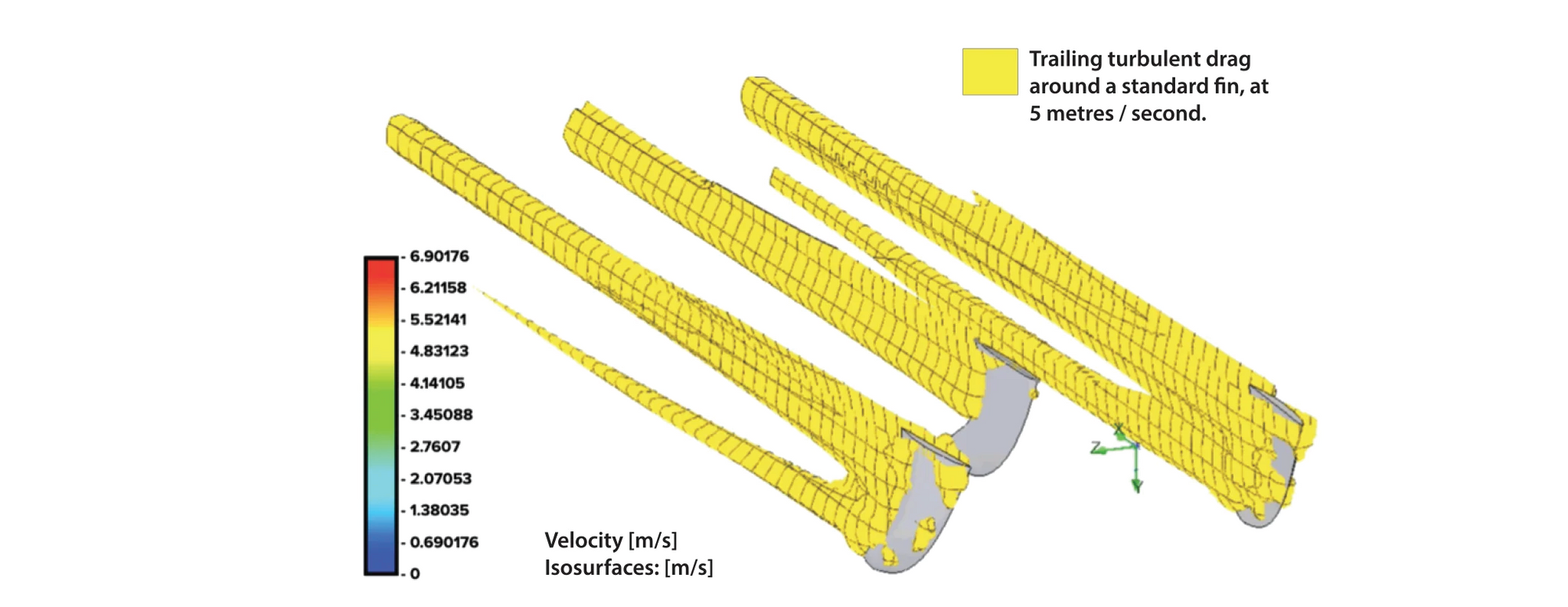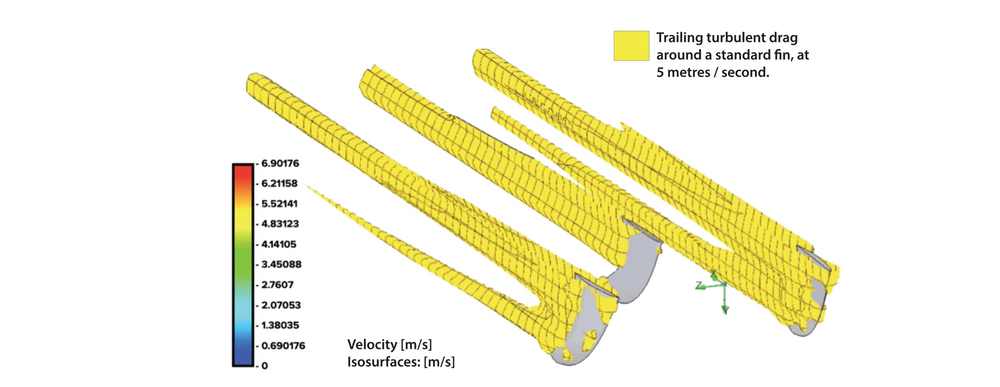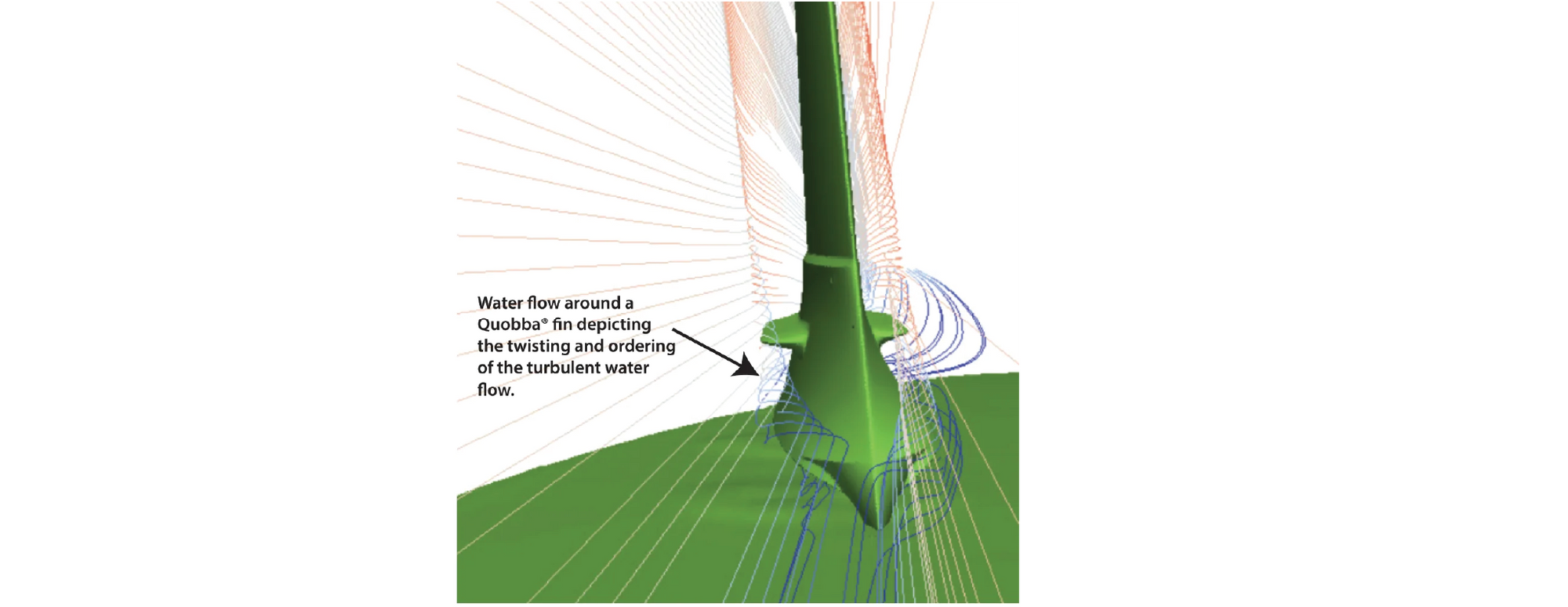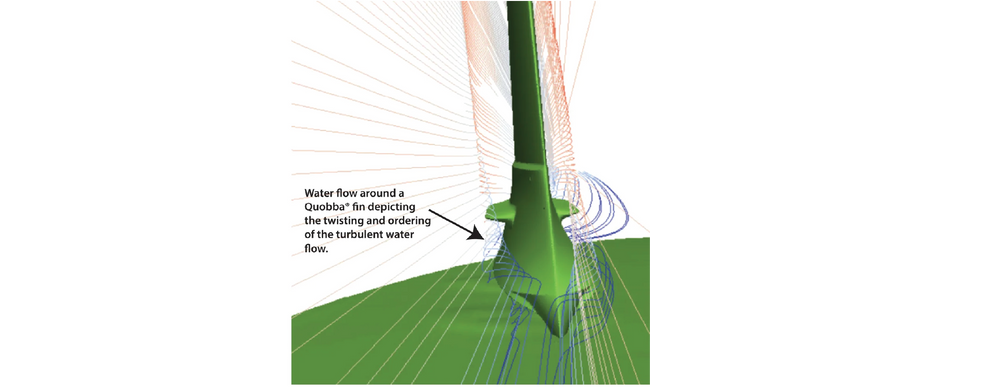Why change standard fin design?
To reduce the trailing turbulent drag around the base of all standard fins, thereby increasing speed, hold and drive.
The problem with current standard fin design
The following figure is from an animated version of an extensive Computer Fluid Dynamics (CFD) analysis of a thruster fin configuration of standard fins, carried out by Anthony Livanos (University of Western Australia) back in 2005.
It clearly shows that most of the trailing turbulent drag (coloured yellow) is around and behind the base of all standard fins.
This is new information, as for the last 40 years the surf industry has generally believed that most trailing turbulent drag was from the tip of the fin.
In this respect, the more turbulence can be reduced around the base and behind the fin, the faster and more efficient a fin will become.
Quobba® Fins have invented, prototyped, fully in-surf tested, produced and now patented an innovative fin shape, that is designed to markedly reduce trailing turbulence drag.
On standard fins, we now understand that approximately 80% of the trailing turbulent drag is from the base of the fin, and not the tip as previously thought.
This is new information, as for the last 40 years the surf industry has generally believed that most trailing turbulent drag was from the tip of the fin.
In this respect, the more turbulence can be reduced around the base and behind the fin, the faster and more efficient a fin will become.
Quobba® Fins have invented, prototyped, fully in-surf tested, produced and now patented an innovative fin shape, that is designed to markedly reduce trailing turbulence drag.
On standard fins, we now understand that approximately 80% of the trailing turbulent drag is from the base of the fin, and not the tip as previously thought.
How can Quobba® Fins reduce trailing turbulent drag?
By ordering the turbulent water flow around the fin base.
How can Quobba® Fins order turbulent water flow?
Using patented technology that consists of the 'Caudal Keel', 'Chop Stopper' and 'Venting'.
As demonstrated in the video, water flows between the 'caudal keel' and 'chop stopper' areas and starts to spin.
The design of Quobba® Fins forces water to twist and move much faster along and around the leading edge of the 'caudal keel'.
This relatively faster flow of water at the leading edge of a Quobba® Fin, causes a low pressure area to be formed, 'sucking' the fin forward.
Bernoulli principle (1738): "Whenever there is a faster flow of water, there shall be a lower pressure."
By forming a circular pattern to the water flow around Quobba® Fins, the typical trailing turbulent drag found around all standard fins, is substantially minimized.
The design of Quobba® Fins forces water to twist and move much faster along and around the leading edge of the 'caudal keel'.
This relatively faster flow of water at the leading edge of a Quobba® Fin, causes a low pressure area to be formed, 'sucking' the fin forward.
Bernoulli principle (1738): "Whenever there is a faster flow of water, there shall be a lower pressure."
By forming a circular pattern to the water flow around Quobba® Fins, the typical trailing turbulent drag found around all standard fins, is substantially minimized.
In 2017, Quobba® Fins commissioned Aurora Offshore Engineering Pty Ltd (‘Aurora’)
Quobba® Fins engaged ‘Aurora’ to compare a standard fin against an identical sized fin with Quobba® technology.
Refer below figure, showing typical ‘streamline flow’ around a Quobba® Fin.
Refer below figure, showing typical ‘streamline flow’ around a Quobba® Fin.
Notice the water around the base of a Quobba® Fin is more ‘ordered’, compared to typical unordered water flow formed around a standard fin.
Conclusion from ‘Aurora’ analysis:
The results of the CFD modelling show a significant change in the flow of water immediately adjacent to the board and downstream of the fins. These flow changes are potential causes fro the observed speed and stability increases for boards with Quobba® Fins technology.
The results of the CFD modelling show a significant change in the flow of water immediately adjacent to the board and downstream of the fins. These flow changes are potential causes fro the observed speed and stability increases for boards with Quobba® Fins technology.
Conclusion from ‘Aurora’ analysis:
The results of the CFD modelling show a significant change in the flow of water immediately adjacent to the board and downstream of the fins. These flow changes are potential causes for the observed speed and stability increases for boards with Quobba® Fins technology.





